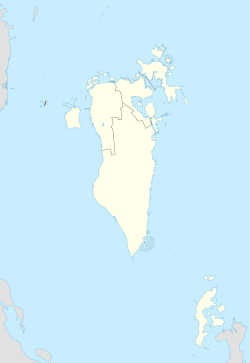A'ali
|
A'ali عالي |
|
|---|---|
| Town | |
| Coordinates: 26°09′07″N 50°31′32″E / 26.15194°N 50.52556°ECoordinates: 26°09′07″N 50°31′32″E / 26.15194°N 50.52556°E | |
| Country | Bahrain |
| Population | |
| • Total | 100,553 |
A'ali (Arabic: عالي) is one of the biggest towns in Bahrain. It was formerly a part of the municipality of Mintaqah but since 2001 lies within the Central Governorate. A'ali is famous for its ancient burial mounds, especially several very large burial mounds in the city centre. A'ali is also famous for its traditional handcrafted pottery, which can be seen and bought from different potters and boutiques in the town.
A'ali is located in the middle of Bahrain island, south of Isa Town and north of Riffa. The town is famous for its burial mounds and is home to the National Driving School. A'ali is a relatively new suburb of Bahrain; first construction in the area started around the late 1970s. Today A'ali is one of the largest towns in Bahrain, home to many of Bahrain's middle and upper class families.
The burial mounds date to the Dilmun era (3200 BC-330 BC). The site was excavated by many foreign archaeological teams throughout the 20th century. An important group of artifacts was excavated by the British archaeologist Ernest Mackay and can now be found in the British Museum, London. It includes an unusual statuette of a nude women with curvaceous body dating from between 2000 and 1500 BC. The discovery of a "new and rare type of burial mound encircled by an outer ring wall" has led archaeologists to believe that specific mounds were made for the social elite, indicating that early Dilmun culture had a class system.
facts was excavated by the British archaeologist Ernest Mackay and can now be found in the British Museum, London. It includes an unusual statuette of a nude women with curvaceous body dating from between 2000 and 1500 BC. The discovery of a "new and rare type of burial mound encircled by an outer ring wall" has led archaeologists to believe that specific mounds were made for the social elite, indicating that early Dilmun culture had a class system.
...
Wikipedia

